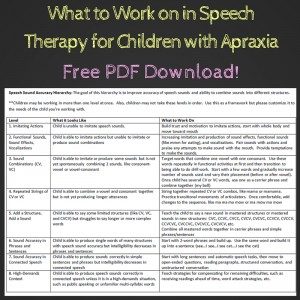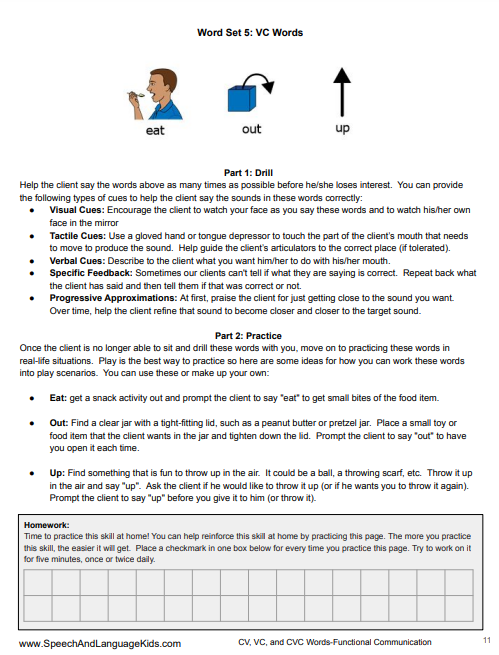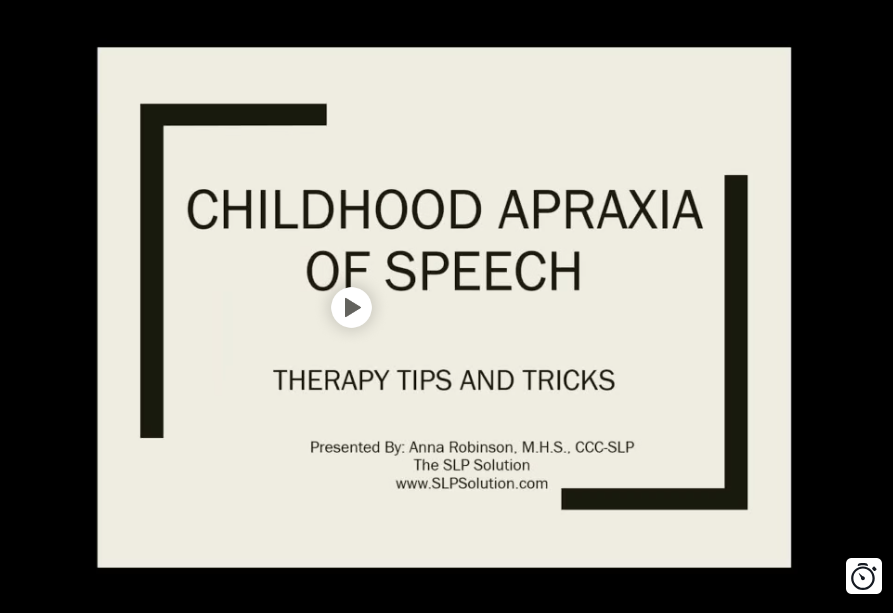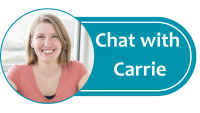Childhood Apraxia of Speech: How to Do Speech Therapy for CAS
Childhood Apraxia of Speech (CAS) is a rare, neurologically-based speech disorder where the child knows what he wants to say but the message gets mixed up in the motor-planning and execution phase so the sounds come out all wrong.
What are the Symptoms of Childhood Apraxia of Speech?
Though the diagnosis of CAS is relatively new, experts have agreed that CAS usually includes these 3 generally-agreed upon components:
- Inconsistent errors on consonants and vowels in repeated productions of syllables or words(meaning that if the child says the same word many times, it may sound differently each time)
- Lengthened and disrupted coarticulatory transitions (meaning that the child’s speech sounds choppy or disconnected due to trouble transitioning between sounds or between words in older children)
- Inappropriate prosody, especially in the realization of lexical or phrasal stress between sounds and syllables (meaning that the rhythm, intonation, and stress of speech may sound off, the child may sound robotic, have incorrect phrasing, or stress the wrong words or syllables)
Listen to the Podcast on Childhood Apraxia of Speech:
Sometimes it can be difficult to know exactly what you should be working on with your children with childhood apraxia of speech. In this podcast episode, I break down speech sound learning in different levels. Then, I give practical therapy activities that can be used for each level. Click the play button below to listen to the entire episode. Or, scroll down to see the notes below.
Free Therapy Levels Chart:
To get started, download the free PDF of the Skill Set Charts for Childhood Apraxia of Speech. This will break down a nice order to help you determine what speech skill to work on next with a child with CAS:

Phases of Speech Therapy for Apraxia of Speech:
Apraxia of Speech Level 1:
Imitating Actions
Start Here For…
- Children who are unable to imitate speech sounds
- Children who are not tuned in enough to work on anything during sessions
- Children who have emotional issues and are not willing to work with you on their speech during sessions
Therapy Activities
- Do a reinforcer probe and offer those preferred reinforcers if the child imitates a basic action like clapping hands, stomping feet, raising hands, etc.
- Take pictures that represent the actions you want the child to do and print them on cards. Have the child draw one card from a bag and do that action.
- Make a movie on your phone where the child is your shadow and imitates what you do (do it in reverse as well).
Apraxia of Speech Level 2:
Functional Sounds, Sound Effects, Vocalizations
Start Here For…
- Children who are able to imitate actions but unable to imitate or produce sound combinations (like CV, VC)
- Children who need a little confidence boost before working on sound combinations (this could be mixed in)
Therapy Activities
- Play with vehicles and make engine sounds (or sirens).
- Feed puppets or stuffed animals and have them make exaggerated “mmmm” noises.
- Have the child request pieces to an animal puzzle by making that animal’s noise (reduce complex noises down to one sound, like “eee” for monkey).
Apraxia of Speech Level 3:
Sound Combinations (CV, VC)
Start Here For…
- Children who are able to imitate or produce some sounds but are not yet spontaneously combining 2 sounds, like consonant- vowel or vowel-consonant
- Children who are doing some sound combinations on their own but can’t say very many (or enough to communicate much)
Therapy Activities
- Get some sort of a riding toy like a bike or a swing and stop the child until he says “go” again.
- Throw small objects up onto a higher surface (like a table), each time, have the child say “up” to indicate he wants another thing to throw up.
- Put coins in a piggy bank and have the child say “in” to get each coin to indicate he wants to put it in.
Apraxia of Speech Level 4:
Repeated Strings of CV or VC
Start Here For…
- Children who are able to combine a vowel and consonant together but are not yet producing longer utterances
- Children who are doing some CV, VC, and CVCV combinations on their own but can’t say very many (or enough to communicate much)
Therapy Activities
- Sequence words that the child can do together to work on articulatory transitions (the same word repeatedly or alternating two words together).
- String together several of a word that the child can say and then add a word that the child can’t say to the end that only varies by one sound (bow, bow, bow, boy).
Apraxia of Speech Level 5:
Add a Structure, Add a Sound
Start Here For…
- Children who are able to say some limited structures (like CV, VC, and CVCV) but struggles to say longer or more complex words
- Children who are able to use some sounds in CV, VC, and CVCV structures but not very many
Therapy Activities
- Increase vowels by sequencing pictures together that start with the same consonant and change the vowel, like “boy, bee, bay, bow, bow”, etc. Lay the cards in a row and have the student say the sequence.
- Increase consonants by using the same vowel and changing the consonant, like “me, tea, key, pea, we, see”.
- Increase structures by taking a known word and adding a sound like, “key…keep, pea…peep, we…weep”.
Apraxia of Speech Level 6:
Sound Accuracy in Phrases and Sentences
Start Here For…
- Children who are able to produce single words of many structures with good speech sound accuracy but intelligibility decreases in phrases and sentences
Therapy Activities
- Create worksheets similar to the previous section where you provide the pictures and they glue them on, but this time, build sentences, like “see..(next line)..I see…I see cat…I see the cat”.
- Use one carrier phrase and fill it with different words that the child has mastered, like “I see bat, I see cat, I see hat, I see mat”. Use flip books if you have them or make your own.
Apraxia of Speech Level 7:
Sound Accuracy in Connected Speech
Start Here For…
- Children who are able to produce sounds correctly in simple sentences and phrases but intelligibility decreases in connected speech
Therapy Activities (work on speaking clearly in tasks with increasing complexity, don’t move on until the previous level is clear)
- Have the child describe pictures using full sentences (“the girl is walking her dog in the park”).
- Have the child complete automatic speech tasks like saying the pledge of allegiance or the months of the year.
- Have the child answer open-ended questions like “tell me about your last birthday party”.
- Have the child read a short paragraph.
- Have a conversation with the child about a specific topic with the expectation that you will be listening for his speech sounds.
- Listen for correct speech sounds in conversational speech and correct using feedback as needed.

About the Author: Carrie Clark, MA CCC-SLP
Hi, I’m Carrie! I’m a speech-language pathologist from Columbia, Missouri, USA. I’ve worked with children and teenagers of all ages in schools, preschools, and even my own private practice. I love digging through the research on speech and language topics and breaking it down into step-by-step plans for my followers.
Connect with Me:
Podcast: Play in new window | Download | Embed
Subscribe: Apple Podcasts | RSS









Love this ! Great way to break down the steps to approach apraxia therapy
I enjoyed this podcast, it was very helpful. Thank you for sharing!
By the way, the link (https://www.speechandlanguagekids.com/episode 59) to the podcast notes you talk about is not working.
Susan-Can you tell me what the podcast was about that you were trying to access? I’ll take a look and see what’s going on for you.